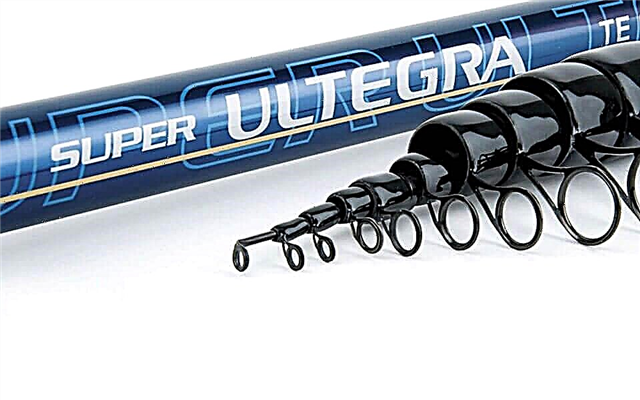What distinguishes a "dirty" city from a "clean" city? No, we are not talking about the work of public utilities and the ability of janitors to wave a broom - this time let's talk about ecology. It is no secret that many of the residents of cities, especially large ones and those where large industrial enterprises are located nearby, complain about the environment. And these complaints are not invented - according to statistics, up to 140 thousand residents of the Russian Federation die from diseases related to the "bad ecology" every year - about 5% of the total number of deaths.

This year, the Ministry of Natural Resources decided to reveal the cards - amounted to list of the dirtiest cities in Russia in 2018whose ecology can be hazardous to health.
10. Chita
 For a year, Chita has been one of the most polluted cities in Russia (the list, in addition to Chita, includes nine more sufferers). Paradoxical as it may seem for such a small city (the population of Chita does not even reach 350 thousand people), one of the reasons is the number of cars per capita. He is ahead of the Chitins in love for his iron friends - no, not even Moscow and not Peter, but Vladivostok. The city is located in a hollow, enclosed by hills, crowded and high-rise buildings - as a result, air circulation is almost absent and, although strong winds often blow there, however, in the winter, Chita is covered with a dense cap of smog.
For a year, Chita has been one of the most polluted cities in Russia (the list, in addition to Chita, includes nine more sufferers). Paradoxical as it may seem for such a small city (the population of Chita does not even reach 350 thousand people), one of the reasons is the number of cars per capita. He is ahead of the Chitins in love for his iron friends - no, not even Moscow and not Peter, but Vladivostok. The city is located in a hollow, enclosed by hills, crowded and high-rise buildings - as a result, air circulation is almost absent and, although strong winds often blow there, however, in the winter, Chita is covered with a dense cap of smog.
 The ancient heating system of the city - the thermal power station, both the first and second, as well as the boiler houses use coal and fuel oil as fuel for the hellish mixture. As the Chitins say, one has only to drive a few kilometers from the city - and you can see how a dirty brown fog hangs over the city, and only black smoke from the state district power station cuts through it. They say it is true that boiler houses are switching to more modern types of fuel, but the results are not yet visible - Chita is still one of the most “dirty” cities in Russia.
The ancient heating system of the city - the thermal power station, both the first and second, as well as the boiler houses use coal and fuel oil as fuel for the hellish mixture. As the Chitins say, one has only to drive a few kilometers from the city - and you can see how a dirty brown fog hangs over the city, and only black smoke from the state district power station cuts through it. They say it is true that boiler houses are switching to more modern types of fuel, but the results are not yet visible - Chita is still one of the most “dirty” cities in Russia.
9. Chelyabinsk
 The rating of the dirtiest cities in Russia in 2018 would not be complete without a “city of harsh men." Historically, the concentration of large industrial enterprises is most of all beyond the Urals. Therefore, Siberians suffer most from the poor ecology. Chelyabinsk was no exception. Both in the city and beyond, there are many industrial enterprises. As a result, Chelyabinsk residents breathe air with a high content of all sorts of different harmful chemicals - for example, phenol, hydrogen sulfide, formaldehyde and so on. Smog in the city hangs almost round the clock.
The rating of the dirtiest cities in Russia in 2018 would not be complete without a “city of harsh men." Historically, the concentration of large industrial enterprises is most of all beyond the Urals. Therefore, Siberians suffer most from the poor ecology. Chelyabinsk was no exception. Both in the city and beyond, there are many industrial enterprises. As a result, Chelyabinsk residents breathe air with a high content of all sorts of different harmful chemicals - for example, phenol, hydrogen sulfide, formaldehyde and so on. Smog in the city hangs almost round the clock.
 The problems are also added by the location of the city - most often (from a third to half of the days in a year) calmness prevails or a weak breeze blows at maximum. In the absence of air movement, the air masses do not mix, and emissions accumulate in the lower part of the atmosphere. And Chelyabinsk citizens are forced to breathe this. The city was also among the worst in Russia in terms of living standards.
The problems are also added by the location of the city - most often (from a third to half of the days in a year) calmness prevails or a weak breeze blows at maximum. In the absence of air movement, the air masses do not mix, and emissions accumulate in the lower part of the atmosphere. And Chelyabinsk citizens are forced to breathe this. The city was also among the worst in Russia in terms of living standards.
Another reason for the adverse environmental situation in the city is that there is nowhere to dump garbage. The main city landfill was completely filled a quarter of a century ago, and this giant mountain of garbage in the summer months starts to blaze from time to time - adding problems to Chelyabinsk residents. Oh yes, and swimming in ponds near Chelyabinsk is not recommended.
8. Omsk
 The environmental situation in the city is best characterized by the presence in the city of the largest oncological center in Siberia. For many years, Omsk has been among the top five Russian cities whose population is most affected by cancer. The reason for the adverse environmental situation is the many industrial enterprises located in the city. The poultry farm also adds aromas - thanks to it, residents of nearby microdistricts do not dare to open the windows to ventilate the apartment. And although there are no enterprises in the city center, their absence more than make up for cars.
The environmental situation in the city is best characterized by the presence in the city of the largest oncological center in Siberia. For many years, Omsk has been among the top five Russian cities whose population is most affected by cancer. The reason for the adverse environmental situation is the many industrial enterprises located in the city. The poultry farm also adds aromas - thanks to it, residents of nearby microdistricts do not dare to open the windows to ventilate the apartment. And although there are no enterprises in the city center, their absence more than make up for cars.
 The Irtysh River, on the banks of which the city stands, although fairly shallow, however, is able to bring many problems to those who dare to swim in it. Here and E. coli, and staphylococcus, and other bacteria that are not averse to settle in humans.
The Irtysh River, on the banks of which the city stands, although fairly shallow, however, is able to bring many problems to those who dare to swim in it. Here and E. coli, and staphylococcus, and other bacteria that are not averse to settle in humans.
True, since 2010, the city has been trying to reduce emissions. To do this, filters are installed at the CHP to capture particles from the smoke, and factory equipment is being modernized. It remains only to solve the garbage problem, which is critical in Omsk - two of the three landfills are closed, and the third does not cope with the gigantic amounts of trash that the million-plus city spews from itself every day.
7. Norilsk
 The main cause of Norilsk pollution is the work of the local Norilsk Nickel metallurgical plant. Every year, without stint, he throws two and a half million tons of sulfur dioxide into the air, which cover the city.
The main cause of Norilsk pollution is the work of the local Norilsk Nickel metallurgical plant. Every year, without stint, he throws two and a half million tons of sulfur dioxide into the air, which cover the city.
As a result of the operation of the enterprise and the poor condition of the treatment facilities, the water in Norilsk is of a unique turquoise-green color due to the increased content of copper sulfate. The surrounding coniferous forests are leafless - acid rain rained their needles. Waste emissions destroyed all the flora and fauna in the lakes near the city. Well, at least thanks to strong winds, the smog in Norilsk almost does not hold.
 It is not surprising that Norilsk is included in the list of the most environmentally dirty cities in Russia in 2018. Norilsk is comforted only by the fact that, according to the world ranking of the dirtiest cities in the world, Norilsk is not yet a leader. Chinese and Indian cities are confidently overtaking him: there, with industrial emissions into the air, the situation is even worse.
It is not surprising that Norilsk is included in the list of the most environmentally dirty cities in Russia in 2018. Norilsk is comforted only by the fact that, according to the world ranking of the dirtiest cities in the world, Norilsk is not yet a leader. Chinese and Indian cities are confidently overtaking him: there, with industrial emissions into the air, the situation is even worse.
6. Novokuznetsk
 Another large industrial Siberian city with an extremely unfortunate location is its territory is bordered by mountains that prevent the winds from blowing through the city. As a result, smog, consisting of automobile and industrial emissions, stagnates over the city.
Another large industrial Siberian city with an extremely unfortunate location is its territory is bordered by mountains that prevent the winds from blowing through the city. As a result, smog, consisting of automobile and industrial emissions, stagnates over the city.
And there are many enterprises in Novokuznetsk - these are factories of ferrous and non-ferrous metallurgy, and coal plants, as well as thermal power plants, without which not a single large city can do. As usual, zealous owners are in no hurry to upgrade equipment - as a result, more than 80% of harmful substances calmly pass through the filters. Therefore, each year up to 300 tons of harmful substances enter the atmosphere of the city, which, due to the low air circulation, are inhaled by the inhabitants of Novokuznetsk.
 There is a problem in the city with landfills - the existing ones can not cope with the volume of garbage. Therefore, random landfills are growing, where citizens dump their waste, which adds unique notes to the atmosphere of the city.
There is a problem in the city with landfills - the existing ones can not cope with the volume of garbage. Therefore, random landfills are growing, where citizens dump their waste, which adds unique notes to the atmosphere of the city.
5. Nizhny Tagil
 Nizhny Tagil was specially mentioned in the presidential decree in May as the only city in the Sverdlovsk region - it was ordered by the highest will to reduce the amount of air emissions in the city by at least 20%. The party said: “It is necessary!” The bourgeois replied: "Yes!" Environmental organizations of the city note the increased activity of factory owners to implement the decree. Despite the fact that it will hit their wallets hard, the environment is expensive. According to calculations, at least 3% of the funds should be allocated from the budget to maintain the ecological situation of the city in an acceptable form. In reality, naturally, no more than 0.02% is allocated.
Nizhny Tagil was specially mentioned in the presidential decree in May as the only city in the Sverdlovsk region - it was ordered by the highest will to reduce the amount of air emissions in the city by at least 20%. The party said: “It is necessary!” The bourgeois replied: "Yes!" Environmental organizations of the city note the increased activity of factory owners to implement the decree. Despite the fact that it will hit their wallets hard, the environment is expensive. According to calculations, at least 3% of the funds should be allocated from the budget to maintain the ecological situation of the city in an acceptable form. In reality, naturally, no more than 0.02% is allocated.
 In Nizhny Tagil, several large industrial enterprises that contribute to the pollution; including the famous Uralvagonzavod on YouTube videos. The leader among them in terms of emissions is the Nizhny Tagil Iron and Steel Works. In addition to air, enterprises also poison water, draining sewage into water sources. True, the situation is no longer as catastrophic as it was once in the early 90s - many "dirty" enterprises went bankrupt and fell apart, while the rest at least somehow comply with the decorum.
In Nizhny Tagil, several large industrial enterprises that contribute to the pollution; including the famous Uralvagonzavod on YouTube videos. The leader among them in terms of emissions is the Nizhny Tagil Iron and Steel Works. In addition to air, enterprises also poison water, draining sewage into water sources. True, the situation is no longer as catastrophic as it was once in the early 90s - many "dirty" enterprises went bankrupt and fell apart, while the rest at least somehow comply with the decorum.
4. Magnitogorsk
 Magnitogorsk is also included in the list of the dirtiest cities in Russia in 2018 in ecology. The local metallurgical plant is one of the largest iron ore processing plants in the country. As a result, the concentration of harmful substances in the atmosphere is exceeded 10-20 times, despite all the efforts of the plant management.
Magnitogorsk is also included in the list of the dirtiest cities in Russia in 2018 in ecology. The local metallurgical plant is one of the largest iron ore processing plants in the country. As a result, the concentration of harmful substances in the atmosphere is exceeded 10-20 times, despite all the efforts of the plant management.
The waters of the Urals flowing to their misfortune also underwent changes - for the sake of the plant, the river was enclosed by a dam, from where water is taken for the needs of the enterprise. However, the used water, although passing through the filters, is drained there. As a result, eating fish caught from there is literally life threatening.
 Residents of the left bank of the Urals, where production is concentrated, are most affected. The city government decided to conduct development exclusively on the right bank of the Urals, where the environmental situation is more or less favorable (and resettle “left bank” there). In the future, it is planned (someday, when there is enough money) to build several small satellite towns of Magnitogorsk, place them in forests and conduct roads to the city. Rumor has it that this will come out cheaper than trying to modernize the city as it is now.
Residents of the left bank of the Urals, where production is concentrated, are most affected. The city government decided to conduct development exclusively on the right bank of the Urals, where the environmental situation is more or less favorable (and resettle “left bank” there). In the future, it is planned (someday, when there is enough money) to build several small satellite towns of Magnitogorsk, place them in forests and conduct roads to the city. Rumor has it that this will come out cheaper than trying to modernize the city as it is now.
3. Lipetsk
 Like Norilsk, Lipetsk suffers from the consequences of finding a large industrial enterprise in the city. The Novolipetsk Metallurgical Plant generously “gives” Lipans 290 thousand tons of harmful emissions a year. And although it is located on the left, lower bank of the Voronezh River, and residential buildings on the higher right bank, but still with a southeast wind, the characteristic smells of a large industrial enterprise, including hydrogen sulfide stench, penetrate the apartments of city residents.
Like Norilsk, Lipetsk suffers from the consequences of finding a large industrial enterprise in the city. The Novolipetsk Metallurgical Plant generously “gives” Lipans 290 thousand tons of harmful emissions a year. And although it is located on the left, lower bank of the Voronezh River, and residential buildings on the higher right bank, but still with a southeast wind, the characteristic smells of a large industrial enterprise, including hydrogen sulfide stench, penetrate the apartments of city residents.
Another city is regularly shaken by scandals - someone quietly at night throws harmful substances into the air in significantly higher quantities than normal. But whoever does this is a mystery covered in darkness.
 In addition to the enterprise, they add their own unique notes to the atmosphere of the city and cars. About one third of the harmful substances in the air - their wheels matter. Concerned Lipovites have introduced continuous monitoring of air quality (by the way, Lipetsk is the only city in Russia that has made such a system) and are trying to modernize traffic in the city to reduce emissions. True, as evil languages say, this is done primarily to cut the budget - since the results are somehow not visible.
In addition to the enterprise, they add their own unique notes to the atmosphere of the city and cars. About one third of the harmful substances in the air - their wheels matter. Concerned Lipovites have introduced continuous monitoring of air quality (by the way, Lipetsk is the only city in Russia that has made such a system) and are trying to modernize traffic in the city to reduce emissions. True, as evil languages say, this is done primarily to cut the budget - since the results are somehow not visible.
The townspeople were lucky only with water - underground springs have not yet affected industrial damage.
2. Krasnoyarsk
 Krasnoyarsk has long been firmly behind the red line of environmental safety. Scientists believe: if everything goes its own way, after 70 years no one can live in the city. In addition to cockroaches, these will survive everywhere.
Krasnoyarsk has long been firmly behind the red line of environmental safety. Scientists believe: if everything goes its own way, after 70 years no one can live in the city. In addition to cockroaches, these will survive everywhere.
In February 2018, the city was filled with yellow fog, almost like in Stephen King's novel. And residents, especially those suffering from diseases of the respiratory system, were not recommended to go out at all. The concentration of harmful substances in this yellow fog is much higher than normal. And also townspeople regularly observe the phenomenon called by them "the black sky". It is not yet coal-black, rather dark gray, but, we suspect, is still ahead.
 To blame, as usual, industrial enterprises (especially the aluminum plant, constantly increasing capacity) and thermal power plants; the amount of car exhaust is not more than 35% of the unique atmosphere of the city. And most of all, human greed is to blame - both large enterprises and private ones use very cheap low-quality coal as fuel. Electric boilers are not available to everyone because of the high prices. So they drown. So the soot settles on the windows, walls and the ground.
To blame, as usual, industrial enterprises (especially the aluminum plant, constantly increasing capacity) and thermal power plants; the amount of car exhaust is not more than 35% of the unique atmosphere of the city. And most of all, human greed is to blame - both large enterprises and private ones use very cheap low-quality coal as fuel. Electric boilers are not available to everyone because of the high prices. So they drown. So the soot settles on the windows, walls and the ground.
1. Bratsk
 Top 10 most dirty cities in Russia closes Bratsk. According to scientists, the environmental situation is to blame for the increased number of oncological diseases among city residents. If the air remains the same degree of pollution, in the future it will only get worse. The reason, as usual, is a number of large industrial enterprises located within the city, including a pulp and paper mill, aluminum plant and hydroelectric power station. Especially unpleasant to the residents of the central region, where all the unique industrial aromas are blown away by the winds.
Top 10 most dirty cities in Russia closes Bratsk. According to scientists, the environmental situation is to blame for the increased number of oncological diseases among city residents. If the air remains the same degree of pollution, in the future it will only get worse. The reason, as usual, is a number of large industrial enterprises located within the city, including a pulp and paper mill, aluminum plant and hydroelectric power station. Especially unpleasant to the residents of the central region, where all the unique industrial aromas are blown away by the winds.
 In addition to emissions from enterprises, in the summer the atmosphere of Bratsk is poisoned by regular forest fires, which burn huge areas every year.
In addition to emissions from enterprises, in the summer the atmosphere of Bratsk is poisoned by regular forest fires, which burn huge areas every year.
Fortunately, the residents of the city have an outlet - the “Brotherly Sea”, or a reservoir where no one discharges sewage and on the shore of which you can safely and safely swim and sunbathe.
Factors of air pollution and the formation of NMU
 First of all, smog was to blame for human diseases - a poisonous fog, which contains many harmful substances that can harm the respiratory system. And not only her - dirty air can cause immune system disorders, causes an increase in blood pressure, the occurrence of pathologies in infants, and can also exacerbate the course of cardiovascular diseases.
First of all, smog was to blame for human diseases - a poisonous fog, which contains many harmful substances that can harm the respiratory system. And not only her - dirty air can cause immune system disorders, causes an increase in blood pressure, the occurrence of pathologies in infants, and can also exacerbate the course of cardiovascular diseases.
A smog arises due to automobile exhausts (the more cars in a city, the harder it is to breathe in it), as well as from harmful emissions if industrial enterprises are located in the city or in close proximity to it.
An important role is played by the location and layout of the city - if it is located in a poorly ventilated lowland, then the chances of residents to get sick with diseases of the respiratory system become higher
How will they “correct” the ecology in Russia?
In addition to compiling this list, the Ministry of Natural Resources also proposed a bill on environmental information to the State Duma. A month after the report, Vladimir Vladimirovich himself consulted with members of the Government, who enlightened the head of government on measures to ease the situation.

According to officials, from 2019 we will begin to live better in terms of environmental safety. It is then that the system of environmental regulation will begin to work.
It consists in the fact that the "dirty" and not very enterprises will switch to more modern and less environmentally hazardous production methods.
First of all, the changes will affect those 300 plants that are responsible for more than half of all industrial emissions in Russia.
True, skeptics report that funds for "clean" production will be produced in Russia itself, and in order to establish their mass production, at least 9 trillion is needed. rub. investments and at least two years of time.
So for now, you have to breathe what you have, dear readers. Or look for another place of residence.












